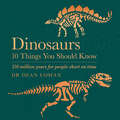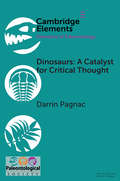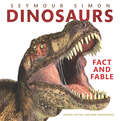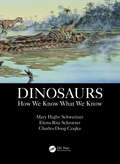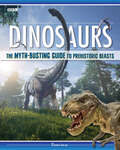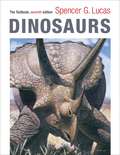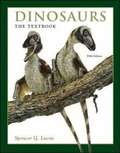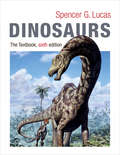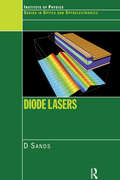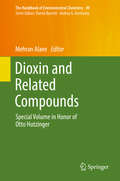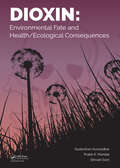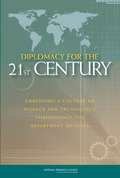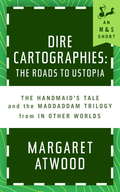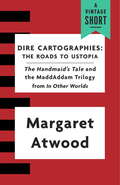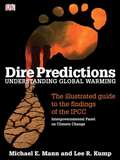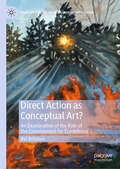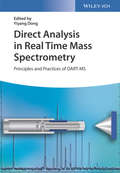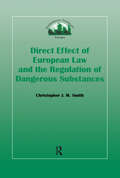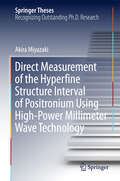- Table View
- List View
Dinosaurs: 10 Things You Should Know
by Dr Dean Lomax'A warp-speed tour of dinosaurs, with an expert guide' PROF. STEVE BRUSATTE, bestselling author of The Rise and Fall of Dinosaurs'A fun, speedy read for grown-ups who love dinosaurs - a great way to get into the subject' PROF. MICHAEL BENTON, author of The Dinosaurs Rediscovered---------Travel back to the prehistoric world and discover the most fascinating parts of the lives of Earth's most awe-inspiring creatures - the dinosaurs. Dr Dean Lomax brings these prehistoric creatures to life in ten bite-sized essays, written for people short on time but not curiosity. Making big ideas simple, Dean takes readers on a journey to uncover what makes a dinosaur a dinosaur, what dinosaurs ate, how they evolved, what caused them to go extinct, and more! Perfect for anyone fascinated by the dinosaur exhibits at museums, palaeontology and fans of Jurassic Park.---------'An eminently accessible read...a perfect primer (or refresher) for dino fans and newbies, yet doesn't skimp on the fascinating details that make 21st-century palaeontology so vibrant' DR REBECCA WRAGG SYKES, author of Kindred
Dinosaurs: A Catalyst for Critical Thought (Elements of Paleontology)
by Darrin PagnacUniversity dinosaur courses provide an influential venue for developing aptitude beyond knowledge of terrestrial Mesozoic reptiles. Passion for dinosaurs, when properly directed, can trigger interest in science and be used to develop critical thinking skills. Examination of dinosaur paleontology can develop competence in information analysis, perception of flawed arguments, recognition of persuasion techniques, and application of disciplined thought processes. Three methods for developing critical thought are outlined in this book. The first uses dinosaur paleontology to illustrate logical fallacies and flawed arguments. The second is a method for evaluating primary dinosaur literature by students of any major. The final example entails critique of dinosaur documentaries based on the appearance of dinosaurs and the disconnect between scientific fact and storytelling techniques. Students are owed more than dinosaur facts; lecturers should foster a set of skills that equips students with the tools necessary to be perceptive citizens and science advocates.
Dinosaurs: Fact and Fable
by Seymour Simon“If you love dinosaurs, you’ll love this book."— Steve Brusatte, paleontologist at the University of Edinburgh and New York Times bestselling author of The Rise and Fall of the DinosaursJoin award-winning science writer Seymour Simon as he separates fact from fiction in a brilliant exploration of some of the most fascinating creatures to ever roam the planet: dinosaurs! This nonfiction picture book is an excellent choice for both shared and independent reading during homeschooling and classroom learning, in particular for children ages 6 to 8.Scientists have dug up and uncovered many facts about dinosaurs—and in the process, they have come across many myths. This picture book digs deep into the Age of Dinosaurs, covering topics such as fossilization, plate tectonics, dinosaur diets, paleontology, extinction theories, dinosaur relatives, and more!Get ready to learn what we know about dinosaurs and what we still don’t know, and about the amazing new discoveries being made every single day.Perfect for young scholars’ school reports, Dinosaurs: Fact and Fable features clear text, vibrantly colored pages, engaging sidebars, and stunning full-color illustrations and photographs. This book includes an author's note, a glossary, a timeline, and an index and supports the Common Core State Standards.Check out these other Seymour Simon books about animals:Big CatsButterfliesCatsCrocodiles & AlligatorsDogsDolphinsElephantsFrogsGorillasHorsesInsectsPenguinsSea CreaturesSnakesSpidersWhalesWild BabiesWolves
Dinosaurs: How We Know What We Know
by Mary Higby Schweitzer Elena Rita Schroeter Charles Doug CzajkaThis textbook introduces research on dinosaurs by describing the science behind how we know what we know about dinosaurs. A wide range of topics is covered, from fossils and taphonomy to dinosaur physiology, evolution, and extinction. In addition, sedimentology, paleo-tectonics, and non-dinosaurian Mesozoic life are discussed. There is a special opportunity to capitalize on the enthusiasm for dinosaurs that students bring to classrooms to foster a deeper engagement in all sciences. Students are encouraged to synthesize information, employ critical thinking, construct hypotheses, devise methods to test these hypotheses, and come to new defensible conclusions, just as paleontologists do. Key Features Clear and easy to read dinosaur text with well-defined terminology Over 600 images and diagrams to illustrate concepts and aid learning Reading objectives for each chapter section to guide conceptual learning and encourage active reading Companion website (teachingdinosaurs.com) that includes supporting materials such as in-class activities, question banks, lists of suggested specimens, and more to encourage student participation and active learning Ending each chapter with a specific "What We Don’t Know" section to encourage student curiosity Related Titles Singer, R. Encyclopedia of Paleontology (ISBN 978-1-884964-96-1) Fiorillo, A. R. Alaska Dinosaurs: An Ancient Arctic World (ISBN 978-1-138-06087-6) Caldwell, M. W. The Origin of Snakes: Morphology and the Fossil Record (ISBN 978-1-4822-5134-0)
Dinosaurs: Over 100 Questions and Answers to Things You Want to Know
by Dan Abnett Nik VincentDid the dinosaurs have armor? Were dinosaurs good parents? Why did the dinosaurs become extinct? Dinosaurs How big were the dinosaurs? Where in the world did the dinosaurs live? You'll find the answers to these and over 100 other intriguing questions inside this beautifully illustrated book.
Dinosaurs: The Myth-busting Guide to Prehistoric Beasts
by BBC ScienceFocusFrom the BBC, a book &“packed with facts and illustrations on the latest finds and theories for dinosaur enthusiasts of all ages.&” —Mike Fredericks, Editor, Prehistoric Times Magazine If everything you know about dinosaurs comes from Hollywood movies, get ready for some surprises in this lively, myth-busting book. The latest scientific research is changing assumptions and providing a far different perspective on these magnificent creatures. Rather than being slow, lumbering and a bit stupid, dinosaurs were smart and nimble-brained—just ask the paleontologists who are peering deep inside the fossilized skulls of these prehistoric animals. Learn how dinosaurs conquered the world, what would have happened if the asteroid hadn't hit Mexico, what T. rex really looked (and sounded) like, and the modern-day dinosaurs living in your back yard. Loaded with in-depth articles and stunning color illustrations, Dinosaurs: The Myth-Busting Guide to Prehistoric Beasts is the ultimate guide to the newest dinosaur discoveries. &“Fun and fascinating . . . find out how the real dinosaurs lived their lives, what they looked like, how they sounded, and how we know all that!&” —Midwest Book Review This is a fixed-format ebook, which preserves the design and layout of the original print book
Dinosaurs: The Textbook
by Spencer LucasGeared toward a broad variety of students, Dinosaurs: The Textbook offers a concise and lucid presentation of the core biological and geological concepts of dinosaur science. Revised throughout to reflect recent fossil discoveries and the current scientific consensus, this seventh edition details the evolution, phylogeny, and classification of various dinosaur species while modeling the best approach for navigating new and existing research.Spencer G. Lucas takes readers through the major taxonomic groups, including theropods, sauropodomorphs, ornithopods, ceratopsians, pachycephalosaurs, stegosaurs, and ankylosaurs. He also examines the behavior and extinction of the dinosaurs, their biological relationship to birds, and their representation (or misrepresentation) in art, literature, film, and other forms of popular culture.This seventh edition of the leading text for introductory courses on dinosaurs incorporates comprehensive updates based on the latest research. Lucas highlights how dinosaur science is rapidly evolving, exploring how new discoveries, methods, and ideas are expanding the frontiers of knowledge. The book features cutting-edge and scientifically rigorous illustrations by leading paleoartists. It also includes extensive and reader-friendly end-of-chapter summary tools, review questions, a detailed glossary, a dinosaur dictionary, and a comprehensive index.
Dinosaurs: The Textbook (Fifth Edition)
by Spencer George LucasTakes students on a journey through various aspects of dinosaur biology, geology, and the history of their discovery. This book presents facts together with ideas, notions, and controversies. It presents dinosaurs as successful, living creatures that were merely different in appearance from other animals.
Dinosaurs: The Textbook (Topics In Geobiology Ser. #51)
by Spencer LucasGeared towards a broad variety of students, Dinosaurs: The Textbook, sixth edition, is a concise and lucid presentation of the biological and geological concepts of dinosaur science. It clarifies the evolution, phylogeny, and classification of the various species while modeling the best approach for navigating new and existing research. Revised to reflect recent fossil discoveries and the current consensus on dinosaur science, this text moves through the major taxonomic groups—including theropods, sauropodomorphs, ornithopods, ceratopsians, pachycephalosaurs, stegosaurs, and ankylosaurs—and concludes with updated chapters on the behavior and extinction of the dinosaurs, their biological relationship to birds, and their representation (or misrepresentation) in art, literature, film, and other forms of popular culture.The sixth edition represents a major revision of the leading text for an introductory course on dinosaurs, including comprehensive updates based on the latest scientific discoveries, research, and literature. With an extensive art program revised by leading paleoartists that features cutting-edge illustrations, it is a complete reader-friendly pedagogical package with extensive end-of-chapter summary tools, review questions, a detailed glossary, a dinosaur dictionary, and a comprehensive index. Please visit our supplemental materials page (https://cup.columbia.edu/extras/supplement/dinosaurs-the-textbook-sixth-edition) to find study and teaching aides for both students and teachers using Dinosaurs: The Textbook, sixth edition in class.
Diode Lasers (Series in Optics and Optoelectronics)
by D. SandsThe compact size, reliability, and low cost of diode lasers lead to applications throughout modern technology-most importantly in modern optical telecommunication systems. This book presents a comprehensive introduction to the principles and operation of diode lasers. It begins with a review of semiconductor physics and laser fundamentals, before describing the most basic homojunction laser. Later chapters describe more advanced laser types and their applications, including the most recently developed and exotic laser designs. The author's intuitive style, coupled with an extensive set of worked examples and sample problems, make this an outstanding introduction to the subject.
Dioxin and Related Compounds
by Mehran AlaeeThis volume is a tribute to Professor Otto Hutzinger, the founding editor of The Handbook of Environmental Chemistry, in recognition of his pioneering work and contribution to our understanding of the sources, fate, exposure and effects of persistent organic pollutants. It consists of fourteen chapters written by individuals who have been inspired by his work and have followed in his footsteps by refining our knowledge of this field and opening new research directions. In Professor Hutzinger's tradition of passing on valuable information to others, the authors present recent advances in areas such as inventories, remediation, and analytical determinations. Levels and trends in abiotic environments, biota, and human exposure via food, as well as the risks to the environment and humans from polychlorinated dibenzo dioxins, furans, and PCBs are also discussed. Other chapters deal with the relevant topics of DDT and its metabolites along with halogenated and phosphorus flame retardants.
Dioxin: Environmental Fate and Health/Ecological Consequences
by Sudarshan Kurwadkar Prabir K. Mandal Shivani SoniDioxin – Environmental Fate and Health/Ecological Consequences offers a unique, and comprehensive coverage of dioxins and their congeners once they are released to the environment. The book provides readers with a systematic understanding of past and emerging sources of dioxins, current dioxins inventories and historical trends, fate and long-range transboundary atmospheric transport, human health, and ecological risk and regulatory perspective. Providing an excellent analysis of dioxin exposure through the food chain and impact on human health, it also documents the environmental implications of dioxins on ecological flora and fauna. The book offers readers a holistic understanding about dioxins, their atmospheric fate and transport, distribution in various environmental matrices and various routes and exposure pathways through which human beings are exposed to this persistent organic pollutant. It further offers an insight into the toxicological profile and mechanistic analysis of the onset of cancer, remediation technologies, and existing regulatory framework to deal with the problems associated with dioxins. The book will serve as an excellent resource to environmental professionals, particularly environmental toxicologists, environmental health professionals, remediation engineers, environmental regulatory agencies, policymakers, and environmental law professionals.
Dioxins and Dioxin-like Compounds in the Food Supply: Strategies to Decrease Exposure
by Committee on the Implications of Dioxin in the Food SupplyDioxin and dioxin-like compounds, or DLCs, are found throughout the environment, in soil, water, and air. People are exposed to these unintentional environmental contaminants primarily through the food supply, although at low levels, particularly by eating animal fat in meat, dairy products, and fish. While the amount of DLCs in the environment has declined since the late 1970s, the public continues to be concerned about the safety of the food supply and the potential adverse health effects of DLC exposure, especially in groups such as developing fetuses and infants, who are more sensitive to the toxic effects of these compounds. Dioxins and Dioxin-like Compounds in the Food Supply: Strategies to Decrease Exposure, recommends policy options to reduce exposure to these contaminants while considering how implementing these options could both reduce health risks and affect nutrition, particularly in sensitive and highly exposed groups, if dietary changes are suggested.
Dioxins and Health: Including Other Persistent Organic Pollutants and Endocrine Disruptors
by Arnold SchecterExplores the latest science on dioxins and other POPs, and their impact on human health Now in its third edition, Dioxins and Health is the most respected reference of its kind, presenting the latest scientific findings on dioxins, dibenzofurans, polychlorinated biphenyls and related compounds, and their impact on human health. The book fully examines the many toxicological effects-including immunological, neurological, developmental, dermatological, and cardiological-these chemicals have on health. This Third Edition has been greatly expanded with the latest research findings on dioxins and related compounds. Moreover, it now includes coverage of other persistent organic pollutants (POPs) and endocrine disruptors, including: Brominated flame retardants, such as polybrominated diphenyl ethers and hexabromocyclododecane Perfluorinated chemicals such as perfluorooctanoic acid and perfluorooctanesulfonic acid Other endocrine disrupting chemicals similar to POPs such as bisphenol A Readers will also learn about the latest findings on the long-term impacts caused by the use of Agent Orange in Vietnam. Other chapters review the Seveso disaster in Italy and the Yusho and Yucheng rice oil poisoning incidents in Japan and Taiwan. In addition, there is a full chapter dedicated to the dioxin poisoning of former Ukraine President Victor Yushchenko. All the chapters in the book have been written by leading international experts. References at the end of each chapter guide readers to the primary literature in the field. Expertly organized in one volume, Dioxins and Health offers readers quick access to essential information about dioxins and related compounds written in clear, simple language that is accessible to not only scientists, clinicians and public health professionals, but also general readers.
Diplomacy for the 21st Century: Embedding a Culture of Science and Technology Throughout the Department of State
by Committee on Science Technology Capabilities at the Department of State"Diplomacy for the 21st Century" recommends steps that the Department of State should embrace to take full advantage of the leading science and technology (S&T) capabilities of the United States. These capabilities provide the department with many opportunities to promote a variety of the interests of the United States and its allies in a rapidly changing world wherein S&T are important drivers of economic development at home and abroad and help ensure international security. This report assesses and makes recommendations concerning the changing environment for the conduct of diplomacy in the years ahead, with a focus on the role of S&T in the development and implementation of U. S. policies and programs. According to this report, prompt steps by the department's leadership are essential to ensure adequate comprehension of the importance of S&T-related developments throughout the world and to incorporate this understanding within the nation's foreign policy for the 21st century. This report also urges the adoption by the department of a broader whole-of-society approach in carrying out its responsibilities at home and abroad - extending beyond traditional interagency coordination and the narrow band of current external partners to include foundations, universities, research centers, and other groups who are extending their international reach.
Diplomacy, Funding and Animal Welfare
by Larry Winter Roeder Jr.Diplomacy, Funding and Animal Welfare is a practical guide to the best diplomatic and negotiation practices needed to convince governments and international institutions to effectively protect animals, which also introduces new approaches to fundraising. Animal protection advocates are prepared for speaking to diplomats and government officials in any setting, and to combatants in war zones. The book mainly focuses on approaching local and national governments, the United Nations system, the international Red Cross movement and systems related to other international organizations that can help animals, often in surprising ways. The reader will learn the rules of "diplomatic protocol", and much about the rules and procedures of major international bodies. To provide balance and real world relevance, the guide draws on a compilation of the author's extensive activities across a range of development, animal welfare, emergency management and climate issues in government and in the NGO world, as well as interviews with scholars and officials from NGOs, diplomatic missions, the United Nations, the Red Cross, governments and corporations.
Dire Cartographies
by Margaret AtwoodIn honor of the thirtieth anniversary of The Handmaid's Tale: Margaret Atwood describes how she came to write her utopian, dystopian works. The word "utopia" comes from Thomas More's book of the same name--meaning "no place" or "good place,"" or both. In "Dire Cartographies," from the essay collection In Other Worlds, Atwood coins the term "ustopia,"" which combines utopia and dystopia, the imagined perfect society and its opposite. Each contains latent versions of the other. Following her intellectual journey and growing familiarity with ustopias fictional and real, from Atlantis to Avatar and Beowulf to Berlin in 1984 (and 1984), Atwood explains how years after abandoning a PhD thesis with chapters on good and bad societies, she produced novel-length dystopias and ustopias of her own. "My rules for The Handmaid's Tale were simple," Atwood writes. "I would not put into this book anything that humankind had not already done, somewhere, sometime, or for which it did not already have the tools." With great wit and erudition, Atwood reveals the history behind her beloved creations.
Dire Cartographies: The Roads to Ustopia and The Handmaid's Tale (A Vintage Short)
by Margaret AtwoodIn honor of the thirtieth anniversary of The Handmaid's Tale: Margaret Atwood describes how she came to write her utopian, dystopian works. The word "utopia" comes from Thomas More's book of the same name--meaning "no place" or "good place," or both. In "Dire Cartographies," from the essay collection In Other Worlds, Atwood coins the term "ustopia," which combines utopia and dystopia, the imagined perfect society and its opposite. Each contains latent versions of the other. Following her intellectual journey and growing familiarity with ustopias fictional and real, from Atlantis to Avatar and Beowulf to Berlin in 1984 (and 1984), Atwood explains how years after abandoning a PhD thesis with chapters on good and bad societies, she produced novel-length dystopias and ustopias of her own. "My rules for The Handmaid's Tale were simple," Atwood writes. "I would not put into this book anything that humankind had not already done, somewhere, sometime, or for which it did not already have the tools." With great wit and erudition, Atwood reveals the history behind her beloved creations.
Dire Predictions
by Michael Mann Lee R. KumpInformation on global climate change drawn from the Fourth Assessment Report of the Intergovernmental Panel on Climate Change (IPCC).
Direct Action as Conceptual Art?: An Examination of the Role of the Communiqué for Ecodefense (Palgrave Studies in Crime, Media and Culture)
by Avi BrismanThis book offers an avenue for understanding the parameters, scope, meanings, and impacts of environmental protest. Focusing on ecodefense, it explores the significance of the communiqué (the written explanation of the reasons for an act of ecodefense), comparing the communiqué to written texts in Conceptual art. It presents and seeks to evaluate the following analogy: act of ecodefense : communiqué :: work of conceptual art : written declaration/statement. By considering the communiqué in this light, this book helps us better comprehend the rationales for “radical environmentalism” undertaken for the purposes of reducing environmental harms, natural resource exploitation, and animal abuse.
Direct Analysis in Real Time Mass Spectrometry: Principles and Practices of DART-MS
by Yiyang DongDART-MS is a relatively new, but very fast evolving technology. Due to its versatility, it addresses fields of crucial importance to people and community, e.g. food or agricultural, forensic, industrial, environmental, medicinal and clinical analysis.
Direct Effect Of European Law
by Christopher J SmithFirst Published in 1995. Routledge is an imprint of Taylor & Francis, an informa company.
Direct Hydroxylation of Methane: Interplay Between Theory and Experiment
by Kazunari YoshizawaThis book focuses on theoretical and computational studies by the editor’s group on the direct hydroxylation of methane, which is one of the most challenging subjects in catalyst chemistry. These studies of more than 20 years include gas-phase reactions by transition-metal oxide ions, enzymatic reactions by two types of methane monooxygenase (soluble and particulate MMO), catalytic reactions by metal-exchanged zeolites, and methane C–H activation by metal oxide surfaces. Catalyst chemistry has been mostly empirical and based on enormous experimental efforts. The subject of the title has been tackled using the orbital interaction and computations based on extended Hückel, DFT, and band structure calculations. The strength of the theoretical studies is in the synergy between theory and experiment. Therefore, the group has close contacts with experimentalists in physical chemistry, catalyst chemistry, bioinorganic chemistry, inorganic chemistry, and surface chemistry. This resulting book will be useful for the theoretical analysis and design of catalysts.
Direct Measurement of the Hyperfine Structure Interval of Positronium Using High-Power Millimeter Wave Technology
by Akira MiyazakiIn this thesis, the author develops new high-power millimeter wave techniques for measuring the hyperfine structure of positronium (Ps-HFS) directly for the first time in the world. Indirect measurement of Ps-HFS in the literature might have systematic uncertainties related to the use of a static magnetic field. Development of the millimeter wave devices supports the precise determination of Ps-HFS by directly measuring the Breit-Wigner resonant transition from o-Ps to p-Ps without the magnetic field. At the same time, the width of the measured Breit-Wigner resonance directly provides the lifetime of p-Ps. This measurement is the first precise spectroscopic experiment involving the magnetic dipole transition and high-power millimeter waves. The development of a gyrotron and a Fabry-Pérot cavity is described as providing an effective power of over 20 kW, which is required to cause the direct transition from o-Ps to p-Ps. Those values measured by the newly developed millimeter wave device pave the way for examining the discrepancy observed between conventional indirect experiments on Ps-HFS and the theoretical predictions of Quantum Electrodynamics.
Direct Mechanisms in Cholesterol Modulation of Protein Function (Advances in Experimental Medicine and Biology #1135)
by Avia Rosenhouse-Dantsker Anna N. BukiyaIn this book, renowned scientists describe how cholesterol interacts with various proteins. Recent progress made in the high-resolution visualization of cholesterol-protein interactions using crystallography and cryogenic electron microscopy has substantially advanced the knowledge of critical features. These features enable specific recognition of the cholesterol molecule by proteins, a process that was built on earlier studies using binding assays, computational modeling and site-directed mutagenesis. Direct Mechanisms in Cholesterol Modulation of Protein Function offers comprehensive insights into the current understanding of cholesterol-driven modulation of protein function via direct sensing. Its nine chapters are organized into two distinct parts. In the first part, the chapters introduce the reader to the general characteristics of cholesterol binding sites in proteins. This part starts with a tour into common cholesterol recognition motifs, followed by an overview of the major classes of steroid-binding proteins. It then continues with two chapters that present a comprehensive analysis of molecular and structural characteristics of cholesterol binding sites in transmembrane and soluble protein domains. In the second part of the book, examples of cholesterol binding sites and consequences of specific cholesterol recognition for protein function are presented for G protein-coupled receptors, ion channels and cholesterol-transporting proteins. The book is valuable for undergraduate and graduate students in biochemistry and nutrition, as well as basic science and medical researchers with a keen interest in the biophysical properties of cholesterol and physiological consequences of cholesterol presence in biological systems.
